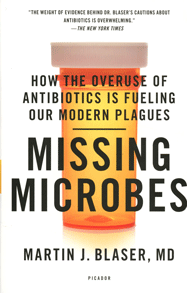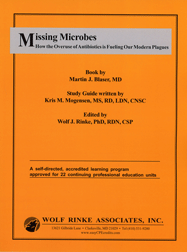|
Missing Microbes:
How the Overuse of Antibiotics is Fueling Our Modern Plagues
Book by Martin J. Blaser, MD
Study Guide written by Kris M. Mogensen, MS, RD, LDN, CNSC
Edited by Wolf J. Rinke, PhD, RDN, CSP
Book, 275 pgs and Study Guide with 1 Reporting Form, 24 pgs.
This ground-breaking CPE program explores how the human microbiome is under assault from an overreliance on medical advances, including antibiotics and caesarian sections, which threatens the symbiotic relationship of bacterial and human cells, and may lead to severe health consequences. Upon completion of this CPE program you will be better able to:
- Discuss changes in disease patterns related to immune dysfunction
- Explain how bacteria can be beneficial to the environment and the human body
- Contrast the ways antibiotics work
- Describe how resistant bacteria develop
- Differentiate the positive and negative roles a particular bacteria may have in the body
For more information and customer comments, click
here.
Approved/Accepted by CDR
For RDs/RDNs & DTRs/NDTRs for the Professional Development
Portfolio
SUGGESTED Performance Indicators (PIs):
6.3.11, 8.1.2, 8.1.3, 8.1.4, 8.1.5, 8.3.1, 8.3.6, 8.4.4, 10.2.7, 10.2.9, 10.4.1, 10.4.2, 10.4.3, 10.4.4, 12.1.3, 12.4.6.
DON'T SEE your Performance Indicators Listed here?
There are many Performance Indicators (PIs) that are applicable but we can't list them all &
Per CDR you may use ANY PI as long as it relates to your Learning Plan.
For details click here.
Share with a friend and Save! Click here for important information about
sharing.
To order an ADDITIONAL Reporting Form click below:
| C264F |
22 CPEUs |
REPORTING FORM |
|
|
Missing Microbes:
How the Overuse of Antibiotics is Fueling Our Modern Plagues
Book by Martin J. Blaser, MD
Study Guide written by Kris M. Mogensen, MS, RD, LDN, CNSC
Edited by Wolf J. Rinke, PhD, RDN, CSP
©2015 Wolf Rinke Associates. No part of this
publication may be reproduced, stored in a retrieval system, or transmitted
in any form or by any means, electronic, mechanical, photocopying,
recording, scanning, or otherwise, without the prior written permission
of the Publisher.
CUSTOMER COMMENTS
Kathy Puckett: "Interesting topic. I agree with overuse of antibiotics promoting problems, but I didn't realize how much it is changing human microbiome."
Jennifer Fielden: "I appreciated how the author included helpful information over various strains of bacteria. Plus, I love how the author backed up his claims with scientific studies. This book was very enlightening and a great read!"
Julie Cottrell: "Content is great. I prefer to read at my own pace in the comfort of my home."
OVERVIEW AND INTRODUCTION
Welcome to the pre-approved, accredited CPE program for Missing Microbes. The program consists of a book of the same title by Martin J. Blaser, MD and this study guide. The CPE program is designed to help you evaluate the changes in disease patterns that may be related to excessive antibiotic use and related changes in the human microbiome. You will also learn about interventions to avoid antibiotic overuse and promote a healthy microbiome. It is also designed to help you earn 22 Level 2, Continuing Professional Education Units (CPEUs).
To get the most out of this CPE program, it is suggested that you adhere to the following four steps:
- Review the objectives in this study guide.
- Read and study the book.
- Assess what you have learned by answering the self-assessment questions in this study guide.
- Compare your answers to the answer key, which you will find at the end of the study guide. If you scored at least 80% (40 questions) correct, you have completed the program and are ready to transfer your answers to the CONTINUING PROFESSIONAL EDUCATION REPORTING FORM in front of this study guide. If you scored less than 80% correct, re-read the appropriate sections of the book and until you score at least 80% correct.
After you have successfully completed the program, complete the CPE REPORTING FORM and:
Submit on-line at www.easyCPEcredits.com,
Or fax to : (410) 531-9282,
Or mail to: Wolf Rinke Associates, 721 Valley Forge Road #486, Valley Forge, PA 19481
We will email your Certificate of Completion.
When you submit your CPE Reporting Form to us via www.easyCPEcredits.com, fax, or mail be sure to write your correct email address in the space provided on the CPE Reporting Form. If writing by hand, be sure to print your email address clearly.
To ensure that our emails are delivered to your inbox (instead of your junk/spam folders), please add cpesupport@wolfrinke.com to your Address Book or Safe List of allowed email senders. Also, be sure to allow attachments from this email address.
LEARNING OBJECTIVES
Upon completion of this CPE program you will be better able to:
- Discuss changes in disease patterns related to immune dysfunction;
- Evaluate the differences between the hygiene hypothesis and the disappearing microbiome hypothesis;
- Compare commensal and symbiotic relationships among bacteria;
- Discuss how bacteria can be beneficial to the environment and the human body;
- Explain the terms pathogenic and latency;
- Discuss how epidemics occur;
- Describe germ theory;
- Recognize the three general ways antibiotics work;
- Evaluate appropriate uses of antibiotics;
- Compare broad spectrum vs. narrow spectrum antibiotics;
- Describe how resistant bacteria develop;
- Identify common resistant bacteria in hospitals and the community;
- Assess the role of antibiotics in animal farming;
- Describe the consequences of antibiotics used in animal farming;
- Evaluate the importance of transition of healthy bacteria from mother to child during birth and lactation;
- Differentiate the positive and negative roles a particular bacteria may have in the body;
- Evaluate the role bacteria may play in the development of obesity and other diseases;
- Analyze the effect of antibiotics on susceptibility to infection; and
- Propose appropriate use of new therapies to combat negative effects of inappropriate antibiotic use.
TABLE OF CONTENTS
1. Modern Plagues
2. Our Microbial Planet
3. The Human Microbiome
4. The Rise of Pathogens
5. The Wonder Drugs
6. The Overuse of Antibiotics
7. The Modern Farmer
8. Mother and Child
9. A Forgotten World
10. Heartburn
11. Trouble Breathing
12. Taller
13. . . .and Fatter
14. Modern Plagues Revisited
15. Antibiotic Winter
16. Solutions
Epilogue
Notes
Acknowledgments
Index
ABOUT THE AUTHOR OF THE BOOK
Martin J. Blaser, MD has studied the role of bacteria in human disease for more than thirty years. He is the director of the Human Microbiome Project at NYU, served as the chair of medicine at NYU and as the president of the Infectious Diseases Society of America, and has had major advisory roles at the National Institutes of Health. He cofounded the Bellevue Literary Review and his work has been written about in publications that include The New Yorker, Nature, The New York Times, The Economist, The Washington Post, and The Wall Street Journal. His more than one hundred media appearances include The Today Show, Good Morning America, NPR, the BBC, The O'Reilly Factor, and CNN. He lives in New York City.
ABOUT THE AUTHOR OF THE STUDY GUIDE
Kris M. Mogensen, MS, RD, LDN, CNSC is a registered dietitian with a Master of Science degree in human nutrition from Framingham State University. She has over twenty years of experience in clinical nutrition. She currently is a Team Leader Dietitian at Brigham and Women's Hospital, Boston, MA and is an Instructor in Nutrition at Boston University College of Health and Rehabilitation Sciences: Sargent College. She has co-authored numerous articles in professional journals, textbook chapters, and professional manuals. She lectures nationally and internationally on nutrition support and medical nutrition therapy. She serves as a peer reviewer for the journals Nutrition in Clinical Practice, the Journal of Parenteral and Enteral Nutrition (JPEN), and Critical Care Nurse.
ABOUT THE EDITOR OF THE STUDY GUIDE
Wolf J. Rinke, PhD, RDN, CSP is the president and founder of Wolf Rinke Associates, a company that has provided high quality CPE programs to nutrition professionals since 1990.
He earned a BS at Drexel University, a MS at Iowa State University, a PhD in Continuing and Vocational Education (Adult Ed) at the University of Wisconsin, and interned at Walter Reed Army Medical Center. He participated in a test item writer workshop sponsored by the Commission on Dietetic Registration (CDR).
Wolf is a past Adjunct Associate Professor, Graduate School of Management & Technology, University of Maryland, and a former Adjunct Faculty Member, School of Continuing Studies, The Johns Hopkins University.
He is the past president of the DC Dietetic Association and has been honored by the Academy with the Award for Excellence in the practice of Management; the Outstanding Dietitian of the Year Award; the Outstanding Service Award; and has delivered the Lenna Frances Cooper Lecture.
At the Academy he has served in numerous leadership roles including Chair, Scholarship Committee, DBC; Chai, Communication Committee, CDR; Chair, Area Coordinating Committee, COE; Chair, COE, and member of Resource for Education Programs Committee; Honors Committee; CDR, Licensure Panel and Ethical Practices Task Force; CDR; House of Delegates and Board of Directors.
He is the author of more than 500 articles, numerous CPE home-study programs, several popular books, and the free monthly eNewsletter "Read and Grow Rich" written specifically for savvy Nutrition Professionals like YOU!
Subscribe now at www.easyCPEcredits.com--you'll be glad you did!
ACKNOWLEDGEMENTS
Special thanks to the following individuals for their careful review of this CPE program:
Rachel Close, MS, RD, CDN, CNSC
Clinical Dietitian
New York Presbyterian-Weill Cornell Medical Center
New York, NY
Barbara B. Klick, MPH, RD
Program Manager
Bariatric Surgery
University Hospital Case Medical Center
Cleveland, OH
University Hospital Geauga Medical Center
Chardon, OH
University Hospital Parma Medical Center
Parma, OH
Patricia Laglenne, MS, RD, LDN, CNSC
Senior Dietitian
Metabolic Support Service
Brigham and Women's Hospital
Boston, MA
If you prefer to order by phone, mail
or fax click below
or click here to contact us with
other questions.
For information about our other products and
services return to the sidebar at the top of the page.
|
|
|


